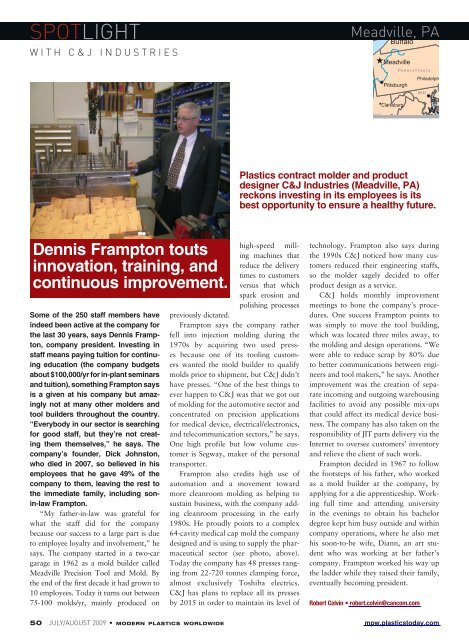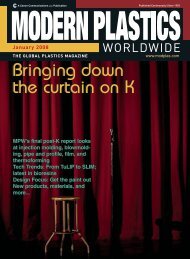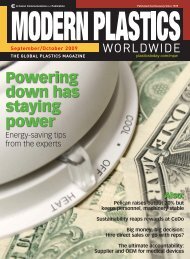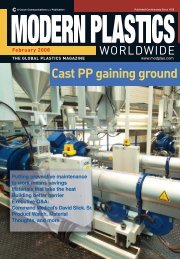Modern Plastics Worldwide - July/August 2009 - dae uptlax
Modern Plastics Worldwide - July/August 2009 - dae uptlax
Modern Plastics Worldwide - July/August 2009 - dae uptlax
Create successful ePaper yourself
Turn your PDF publications into a flip-book with our unique Google optimized e-Paper software.
SPOTLIGHT<br />
WITH C&J INDUSTRIES<br />
Dennis Frampton touts<br />
innovation, training, and<br />
continuous improvement.<br />
Some of the 250 staff members have<br />
indeed been active at the company for<br />
the last 30 years, says Dennis Frampton,<br />
company president. Investing in<br />
staff means paying tuition for continuing<br />
education (the company budgets<br />
about $100,000/yr for in-plant seminars<br />
and tuition), something Frampton says<br />
is a given at his company but amazingly<br />
not at many other molders and<br />
tool builders throughout the country.<br />
“Everybody in our sector is searching<br />
for good staff, but they’re not creating<br />
them themselves,” he says. The<br />
company’s founder, Dick Johnston,<br />
who died in 2007, so believed in his<br />
employees that he gave 49% of the<br />
company to them, leaving the rest to<br />
the immediate family, including sonin-law<br />
Frampton.<br />
“My father-in-law was grateful for<br />
what the staff did for the company<br />
because our success to a large part is due<br />
to employee loyalty and involvement,” he<br />
says. The company started in a two-car<br />
garage in 1962 as a mold builder called<br />
Meadville Precision Tool and Mold. By<br />
the end of the first decade it had grown to<br />
10 employees. Today it turns out between<br />
75-100 molds/yr, mainly produced on<br />
50 JULY/AUGUST <strong>2009</strong> • MODERN PLASTICS WORLDWIDE mpw.plasticstoday.com<br />
West<br />
Buffalo<br />
Meadville<br />
Pittsburgh<br />
Clarksburg<br />
Pennsylvania<br />
Philadelph<br />
MD<br />
Ba<br />
Wa<br />
<strong>Plastics</strong> contract molder and product<br />
designer C&J Industries (Meadville, PA)<br />
reckons investing in its employees is its<br />
best opportunity to ensure a healthy future.<br />
high-speed milling<br />
machines that<br />
reduce the delivery<br />
times to customers<br />
versus that which<br />
spark erosion and<br />
polishing processes<br />
previously dictated.<br />
Frampton says the company rather<br />
fell into injection molding during the<br />
1970s by acquiring two used presses<br />
because one of its tooling customers<br />
wanted the mold builder to qualify<br />
molds prior to shipment, but C&J didn’t<br />
have presses. “One of the best things to<br />
ever happen to C&J was that we got out<br />
of molding for the automotive sector and<br />
concentrated on precision applications<br />
for medical device, electrical/electronics,<br />
and telecommunication sectors,” he says.<br />
One high profile but low volume customer<br />
is Segway, maker of the personal<br />
transporter.<br />
Frampton also credits high use of<br />
automation and a movement toward<br />
more cleanroom molding as helping to<br />
sustain business, with the company adding<br />
cleanroom processing in the early<br />
1980s. He proudly points to a complex<br />
64-cavity medical cap mold the company<br />
designed and is using to supply the pharmaceutical<br />
sector (see photo, above).<br />
Today the company has 48 presses ranging<br />
from 22-720 tonnes clamping force,<br />
almost exclusively Toshiba electrics.<br />
C&J has plans to replace all its presses<br />
by 2015 in order to maintain its level of<br />
Meadville, PA<br />
technology. Frampton also says during<br />
the 1990s C&J noticed how many customers<br />
reduced their engineering staffs,<br />
so the molder sagely decided to offer<br />
product design as a service.<br />
C&J holds monthly improvement<br />
meetings to hone the company’s procedures.<br />
One success Frampton points to<br />
was simply to move the tool building,<br />
which was located three miles away, to<br />
the molding and design operations. “We<br />
were able to reduce scrap by 80% due<br />
to better communications between engineers<br />
and tool makers,” he says. Another<br />
improvement was the creation of separate<br />
incoming and outgoing warehousing<br />
facilities to avoid any possible mix-ups<br />
that could affect its medical device business.<br />
The company has also taken on the<br />
responsibility of JIT parts delivery via the<br />
Internet to oversee customers’ inventory<br />
and relieve the client of such work.<br />
Frampton decided in 1967 to follow<br />
the footsteps of his father, who worked<br />
as a mold builder at the company, by<br />
applying for a die apprenticeship. Working<br />
full time and attending university<br />
in the evenings to obtain his bachelor<br />
degree kept him busy outside and within<br />
company operations, where he also met<br />
his soon-to-be wife, Diann, an art student<br />
who was working at her father’s<br />
company. Frampton worked his way up<br />
the ladder while they raised their family,<br />
eventually becoming president.<br />
Robert Colvin • robert.colvin@cancom.com









